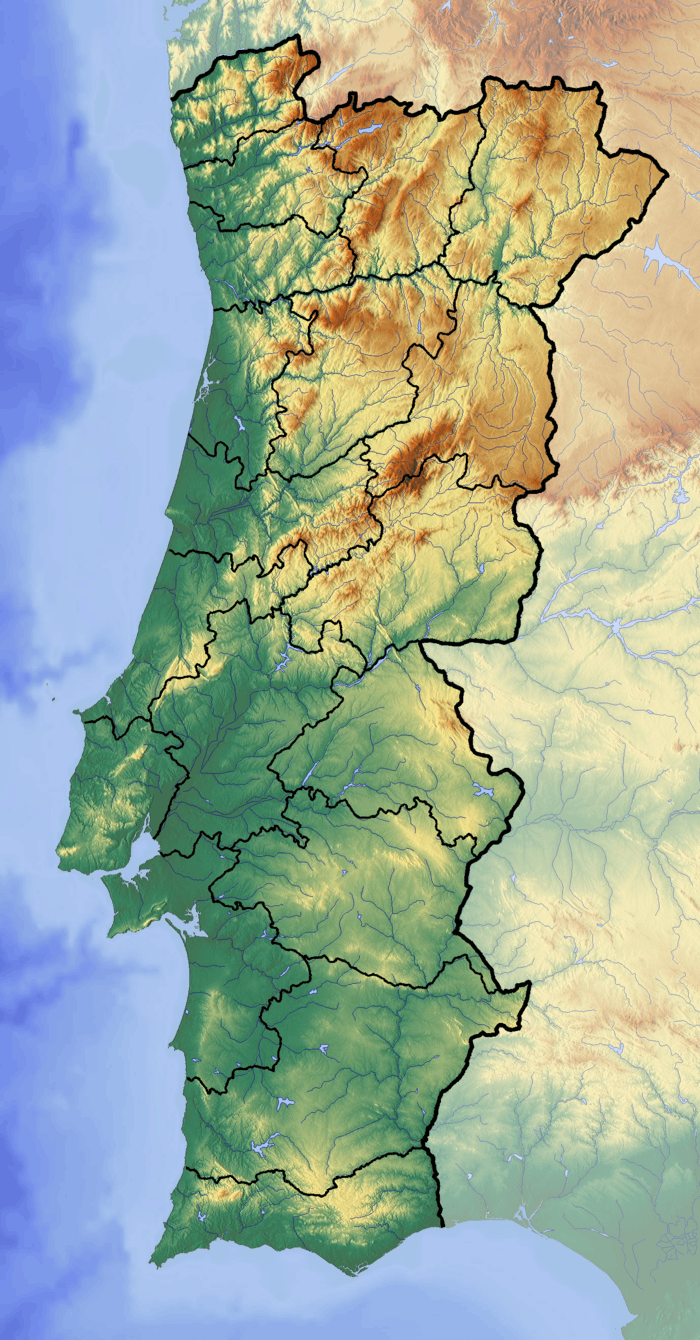Salamonde Dam
| Salamonde Dam | |
|---|---|
 | |
 Location of Salamonde Dam in Portugal | |
| Official name | Barragem de Salamonde |
| Location | municipality Vieira do Minho, Braga District, Portugal |
| Coordinates | 41°41′30.6″N 8°5′28.5″W / 41.691833°N 8.091250°WCoordinates: 41°41′30.6″N 8°5′28.5″W / 41.691833°N 8.091250°W |
| Purpose | Power |
| Status | Operational |
| Opening date | 1953 |
| Owner(s) | Companhia Portuguesa de Produção de Electricidade |
| Dam and spillways | |
| Type of dam | Concrete arch dam |
| Impounds | Cávado River |
| Height (foundation) | 75 m (246 ft) |
| Length | 284 m (932 ft) |
| Elevation at crest | 281 m (922 ft) |
| Dam volume | 93,000 m3 (3,300,000 cu ft) |
| Spillway type | Over the dam |
| Spillway capacity | 1,700 m3/s (1.4 acre⋅ft/s) |
| Reservoir | |
| Total capacity | 65,000,000 m3 (53,000 acre⋅ft) |
| Active capacity | 56,300,000 m3 (45,600 acre⋅ft) |
| Surface area | 2.42 km2 (0.93 sq mi) |
| Normal elevation | 280 m (920 ft) |
| Operator(s) | Energias de Portugal |
| Commission date |
Salamonde I: 1953 Salamonde II: 2015 |
| Hydraulic head |
Salamonde I: 125 m (410 ft) (max) Salamonde II: ? |
| Turbines |
Salamonde I: 2 x 21.8 MW Francis-type Salamonde II: 1 x 207 MW Francis-type |
| Installed capacity |
Salamonde I: 42 MW Salamonde II: 207 MW |
| Annual generation |
Salamonde I: 231.2 GWh Salamonde II: 386 GWh |
Salamonde Dam (Portuguese: Barragem de Salamonde) is a concrete arch dam on the Cávado River, where the river forms the border line between the districts of Braga and Vila Real. It is located in the municipality Vieira do Minho, in Braga District, Portugal.
The dam was completed in 1953. It is owned by Companhia Portuguesa de Produção de Electricidade (CPPE). The dam was designed by Coyne et Bellier.[1]
Dam
Salamonde Dam is a 75 m tall (height above foundation) and 284 m long arch dam with a crest altitude of 281 m. The volume of the dam is 93,000 m³. The dam features a spillway with 4 gates over the dam (maximum discharge 1,700 m³/s) and one bottom outlet (maximum discharge 130 m³/s).[1]
Reservoir
At full reservoir level of 280 m (maximum flood level of 280.5 m) the reservoir of the dam has a surface area of 2.42 (2.36)[2] km² and a total capacity of 65 mio. m³; its active capacity is 56.3 (55[3] or 57[4]) mio. m³.[1] With the 55 mio. m³ water 26.9 GWh can be produced.[3]
Power plant
Salamonde I
The hydroelectric power plant went operational in 1953. It is operated by EDP. The plant has a nameplate capacity of 42[1][2][3][4][5] MW. Its average annual generation is 231.2[3] (175,[4] 232[1][5] or 244[2]) GWh.
The power station contains 2 Francis turbine-generators with 21.8 MW (25 MVA) each in an underground powerhouse. The turbine rotation is 428 rpm. The minimum hydraulic head is 78 m, the maximum 125 m. Maximum flow per turbine is 22 m³/s.[3] The turbines and generators were provided by Voith.[5]
Salamonde 2
In 2011 Alstom has been awarded a contract by EDP to install a 207 MW Francis reversible pump turbine and a 244 MVA motor-generator in a new pumped-storage power plant.[6] The new power plant is expected to go operational in August 2015. Its average annual generation is estimated to be 386 GWh.[7]
See also
External links

- "Hydroelectric Plants in Portugal". Power Plants Around the World. Archived from the original on 2014-07-16. Retrieved 2015-02-24.
References
- 1 2 3 4 5 "SALAMONDE DAM". APA Barragens de Portugal. Retrieved 2015-02-25.
- 1 2 3 "DECLARAÇÃO AMBIENTAL 2012" (PDF) (in Portuguese). Energias de Portugal. p. 24 (22). Retrieved 2015-02-25.
- 1 2 3 4 5 "Salamonde Informação Técnica" (in Portuguese). Energias de Portugal. Retrieved 2015-02-25.
- 1 2 3 "Hidroelectricidade em Portugal memória e desafio" (PDF) (in Portuguese). Rede Eléctrica Nacional, S.A. p. 29 (27). Retrieved 2015-02-25.
- 1 2 3 "Salamonde Hydroelectric Power Plant Portugal". Global Energy Observatory. Retrieved 2015-02-25.
- ↑ "Alstom to supply a 207 MW turbine to Salamonde pumped storage plant in Portugal". Power Engineering. 2011-06-15. Retrieved 2015-02-25.
- ↑ "Salamonde II Informação Técnica" (in Portuguese). Energias de Portugal. Retrieved 2015-02-25.